The Long Cruel Reach of Indonesia’s Death Penalty
ASIA--PACIFIC, 1 Aug 2016
Liliana Segura – The Intercept
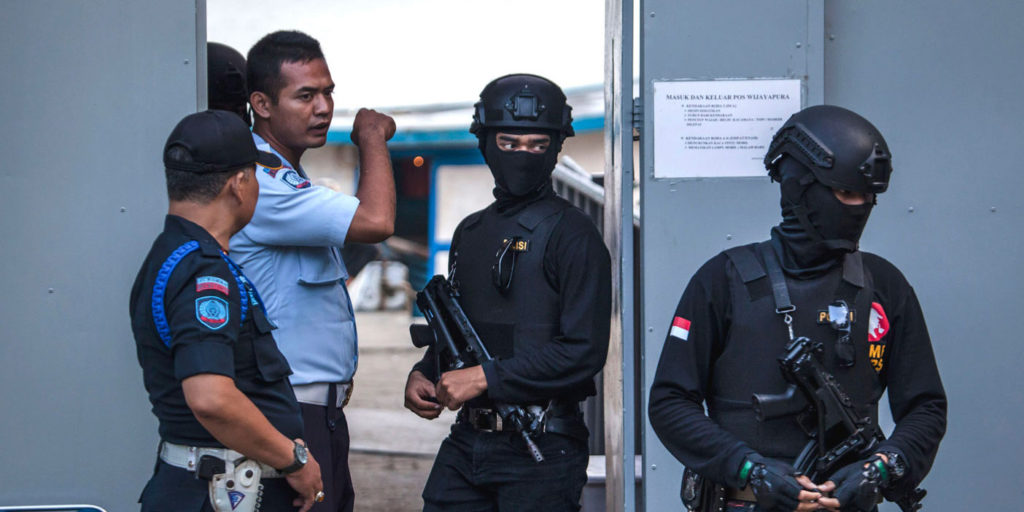
Indonesian police guard Wijaya Pura port, which is the entrance gate to Nusa Kambangan prison, as Indonesia prepares for its third round of drug executions on July 27, 2016, in Cilacap, Central Java, Indonesia.
Photo: Ulet Ifansasti/Getty Images
28 Jul 2016 – On July 25, in the Indonesian port town of Cilacap, a 52-year-old Pakistani man was placed in an ambulance and transferred to Nusa Kambangan, otherwise known as “execution island.” Zulfiqar Ali, a textile worker, was arrested for possessing heroin in 2004; like many caught with drugs in Indonesia, he was convicted and sentenced to die. Human rights activists denounced his case; Ali had been tortured into signing a confession, they said, and his primary accuser had retracted his statements at trial. Nonetheless, on Monday, the Sydney Morning Herald reported, while Ali recovered from stomach and kidney surgery, government officials came for him at the hospital. He was slated to die four days later, shot by a firing squad shortly after midnight.
Ali was not alone. Earlier this year, the Indonesian government announced it would soon execute more than a dozen unnamed prisoners, the third round of executions following a four-year moratorium on capital punishment. The announcement — part of a zero-tolerance drug policy implemented under President Joko Widodo in 2013 — sparked grim speculation about who might be next to die. There were the three drug offenders transferred to Nusa Kambangan from Batam, a different island prison, in early May, as reported by the Jakarta Post. Or four “black-skinned people from Nigeria,” in the words of the sentencing judge in the case of Humphrey “Jeff” Ejike Eleweke, who was targeted for surveillance because of his nationality — and who swore he was innocent. By Thursday morning, July 28, newspapers reported, coffins were being ferried to Nusa Kambangan, while family members and spiritual advisers were given name tags for their final visits — “an indication that executions were imminent.” Yet, when it came time to carry out the executions later that night, only four of the 14 were killed. Early reports out of Indonesia said it was unclear who was among the dead. Later, it was revealed that Ali’s life had been spared.
The unexpected turn of events echoed a different last-minute reprieve, one that occurred in 2015. In late June, thousands of miles from Nusa Kambangan, a diminutive Filipino woman spoke from a stage at the Oslo Opera House, a sleek white building on the harbor of Norway’s capital city. “My name is Celia Veloso,” she said in her native Tagalog. “I am the mother of Mary Jane Veloso, who is on death row in Indonesia.” Arrested at the Java airport with heroin in her suitcase, Mary Jane was nearly executed in April 2015 alongside eight other drug convicts, but was spared at the last second. The hasty reprieve was so unexpected that people in the Philippines awoke the next day to inaccurate headlines reporting her death.
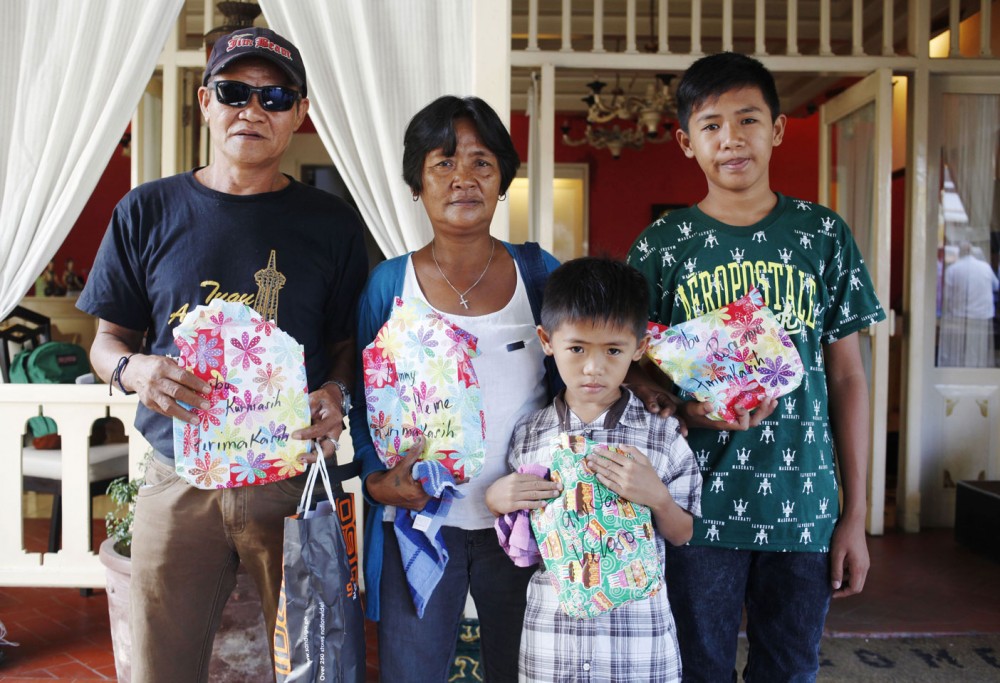
The family members of Philippine death row drug convict Mary Jane Veloso — her father, Caesar, mother, Celia, and sons Mark Darren and Mark Danniel — wait outside the Yogyakarta prison on Jan. 12, 2016, before visiting Veloso to celebrate her 31st birthday.
Photo: Suryo Wibowo/AFP/Getty Images
Mary Jane is the youngest of five children and has two sons of her own. Her mother, who struggled to make a living as a street vendor, described how her daughter had been offered employment as a domestic worker abroad, at the behest of a relative named Kristina Sergio. In reality, Sergio was a drug smuggler who allegedly planted the heroin inside Mary Jane’s suitcase. Even as her daughter sat in an Indonesian jail in the spring of 2010, Veloso recalled, Sergio assured her and her husband “that Mary Jane was happy and that her employer was kind.” It was only when Mary Jane called home that her parents learned the truth.
Yet it was Sergio who later stood in the way of Mary Jane’s execution, by turning herself in to police in Manila just hours before she was to die. With Sergio’s own trial now underway, Mary Jane is set to testify against her. Her family hopes that her testimony will force the Indonesian government to recognize she was a victim and commute her sentence altogether. “We long for the day when she will be reunited with her sons,” her mother said in Oslo, breaking down in tears. “We hope with your help that she can return to the Philippines and start a new life.”
The people in the audience included lawyers, academics, and human rights activists. They had traveled from 121 counties for the Sixth World Congress Against the Death Penalty, a three-day event featuring speeches, panels, and artistic performances. Inside the Opera House, there was anti-death penalty artwork by high school students; an “Abolitionist Village” housing activist booths and literature; and a large map of the world highlighting “retentionist countries” — the label given to nations that hold on to capital punishment. Outside, in the heart of Oslo’s fashionable tourist center, red and blue banners lined the street where visitors dined and shopped, carrying the event’s official logo, a handprint reading ¡ABOLITION NOW!
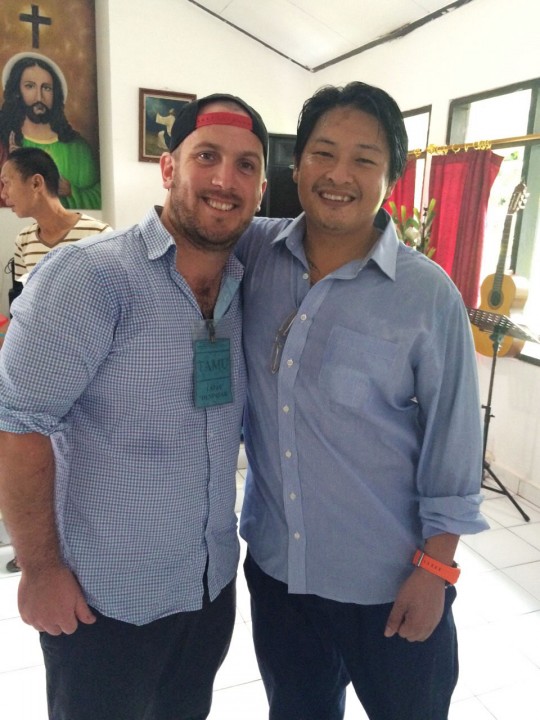
Paul Wilkins and Andrew Chan in January 2015 at a church service inside Kerobokan prison in Bali.
Source: Paul Wilkins
The first World Congress, in 2000, was inspired by a French polemic titled “Open Letter to the American People for the Abolition of the Death Penalty.” The organizers’ scope soon broadened beyond the United States; today, Ensemble Contre la Peine de Mort (ECPM) — or Together Against the Death Penalty — holds the World Congress in a different city every three years. Although there were plenty of Americans in Oslo, the panels and speakers focused largely on other regions, particularly Asia and the Arab world. One major theme was the growing problem of terrorism, which has sparked a resurgence of capital punishment in many countries.
But in Indonesia, the deadliest offenses are drug crimes. All 14 people executed last year were convicted of drug trafficking, and all but two were foreign nationals. With hundreds of Indonesians on death row in other countries, many have decried the hypocrisy of a government that fights to save their own people while targeting foreigners for execution. As a reporter for the Jakarta Globe wrote in 2011, “How can Indonesia expect other countries to grant clemency for our citizens while standing firm on the death penalty for foreign convicts in this country?”
With Indonesian officials hinting they would carry out new executions after Ramadan ended, the specter of new executions loomed in Oslo last month. One Indonesian speaker displayed a graph showing how executions rise during election years. Another presenter discussed the case of a Brazilian man named Rodrigo Gularte, among those shot to death after Mary Jane won her reprieve. News reports described how Gularte, a paranoid schizophrenic, was unaware of what was going to happen to him until he was taken out of his cell. “Am I being executed?” he asked.
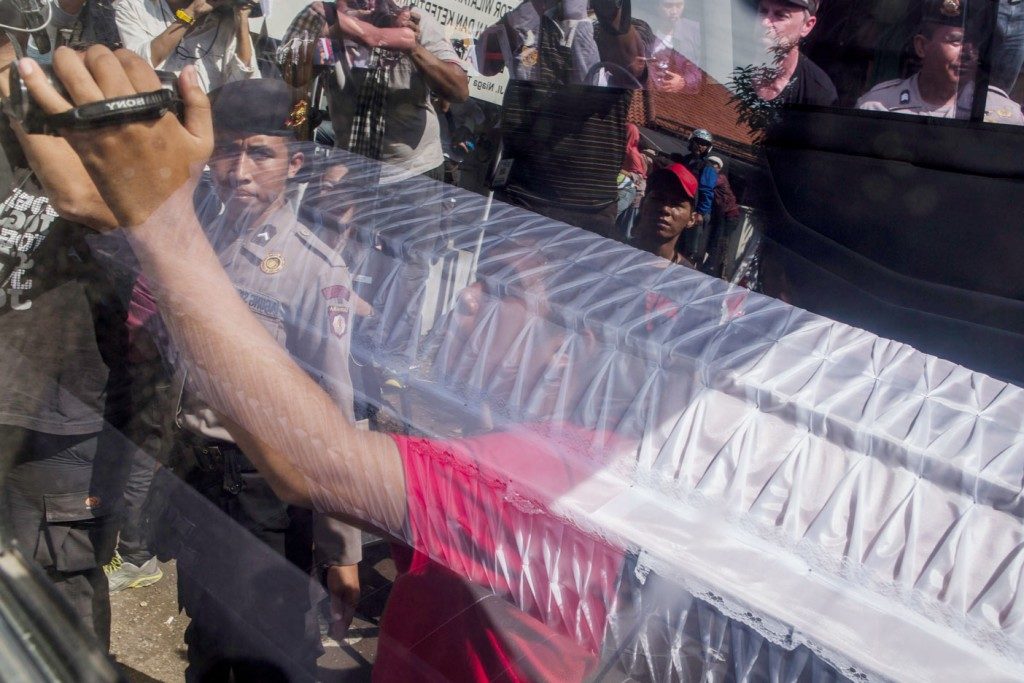
A coffin arrives at Wijaya Pura port for transfer to Nusa Kambangan ahead of the executions of the Bali Nine on April 28, 2015, in Cilacap, Central Java, Indonesia.
Photo: Ulet Ifansasti/Getty Images
A few rows from the front as Celia Veloso spoke was Paul Wilkins, an Australian man in his 30s. A bartender from Melbourne, he traveled to Oslo alone after seeing the event advertised by the human rights group Reprieve. Wilkins did not know Veloso or her daughter. But he knew as much about Mary Jane’s plight as anyone in the room. He could picture the visiting area where she had said her tearful goodbyes to her sons; he had seen the guards who according to media reports had cried as Mary Jane begged for more time. And he knew the field where the others had met their deaths later that night. He had glimpsed it in person and seen it again and again in his mind. It was the place where his friend, 31-year-old Andrew Chan, had died — one of the eight shot by a firing squad in April of last year.
Chan was one of the famed Bali Nine, a group of Australians convicted of drug trafficking in 2006. Along with a man named Myuran Sukumaran, Chan had recruited drug mules to smuggle heroin into Australia. Both were sentenced to death. While in prison, Chan had become deeply religious, evolving into a role model for his fellow prisoners. As his execution neared, his case became a cause célèbre, with politicians and celebrities trying to intervene. But Paul knew Chan simply as Andy, a family friend whose company he’d come to enjoy. They talked trash about each other’s favorite rugby teams and cracked dark jokes — “We had a fairly similar sense of humor,” Paul recalls. After Chan was flown in shackles from Bali to Nusa Kambangan, Paul recalled, he laughed at the absurdity of the security video that had been played prior to takeoff. “If the plane’s going down, I’m clearly going down with it,” he said.
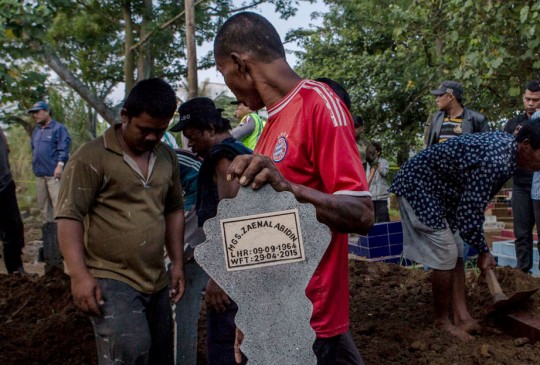
A worker holds the tombstone of Zaenal Abidin, one of eight drug convicts executed, during a funeral service at Nusa Kambangan prison on April 29, 2015, in Cilacap, Central Java, Indonesia.
Photo: Ulet Ifansasti/Getty Images
Wilkins had never given much thought to the death penalty before he met Chan, but then members of his family began visiting him in 2006. His parents were retired and very active in their church; they forged a deep connection with Chan and his family, returning to Bali repeatedly and eventually constructing a guesthouse near the prison where relatives could stay. Wilkins was skeptical at first. “It was like, what are you helping this guy out for?” he recalled. Chan was undeniably guilty of serious crimes, even if he did not necessarily deserve to die for them. But in early 2012, while working as a travel agent, Wilkins went to Bali and met Chan in person. With a scar across his head and “tattoos everywhere,” Chan looked every bit the thug Wilkins had read about in the press. Yet he found Chan to be disarming, laid back, and “very personable.” Wilkins was especially impressed with his strength behind bars — he could tell during his visits that many of the drug convicts were finding ways to sustain their addictions behind bars. Yet Chan stayed clean, focusing on cooking and teaching religion. The same traits that had helped him rise up in the drug trade now made him an influential leader in prison. In the months leading up to his death, Wilkins recalled, “There was a steady stream of ex-prisoners who would come in and visit him.” Many were doing well, had jobs and families. “And they’d come in basically to thank him for that. Seeing that firsthand made me think, ‘Well, if Andrew could do it, then you know, other people’s lives can be changed.’”
On March 4, 2015, Chan and Sukumaran — a talented artist known to Wilkins by his nickname, “Myu” — were flown from Bali to Cilacap, a signal that their execution was weeks away. The transfer was a show of force; police in riot gear stood by while an armored “Barracuda” vehicle came to take the men. The next month, on April 25, Indonesian officials gave the state’s minimum 72 hours of notice that Chan, Sukumaran, and six others would be executed within days. On April 28, they were dressed in white and led to the field, with Chan leading them in singing “Amazing Grace.” Tied to cross-shaped poles and lined up in a row, the group declined to wear the blindfolds offered to them by the prison. At his funeral, Chan’s wife, Febyanti — who he married as a last wish granted by the government — described how Chan had worn his much-hated glasses so he could look his executioners in the eye.
Chan’s funeral was held at the largest church in Sydney. Hundreds attended and thousands more watched it via live-stream. A childhood friend of Chan’s read a eulogy he had penned for himself before he died. “Ask yourself, what story did I leave you with?” he wrote. “That will determine my legacy.”
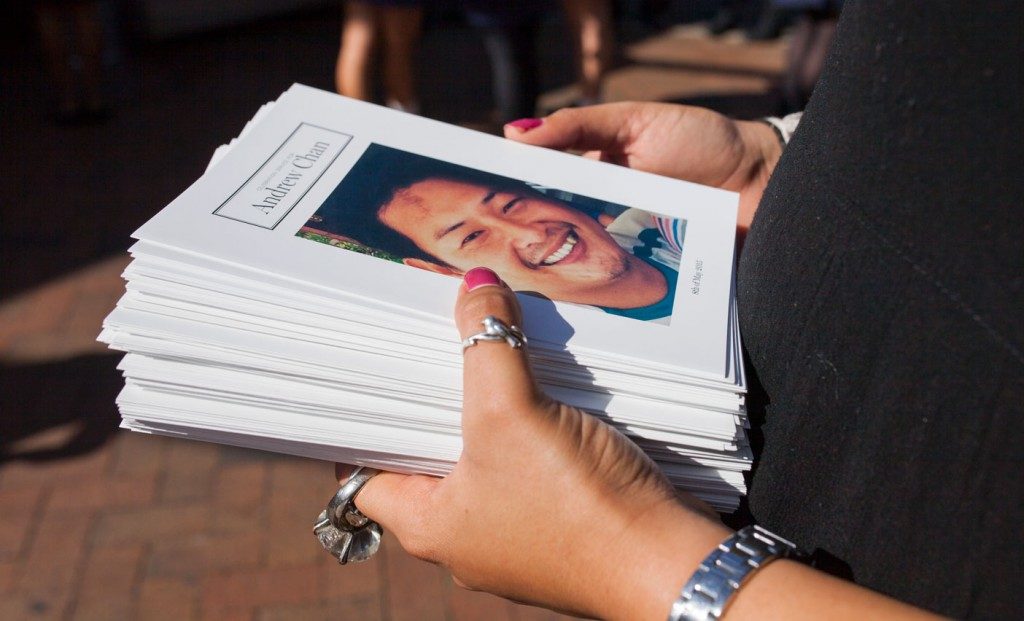
A booklet shows a photo of Andrew Chan on the cover during his funeral service at Hillsong Church on May 8, 2015, in Sydney, Australia.
Photo: Hillsong Church/Getty Images
In Oslo, Wilkins introduced himself to as many people as he could. It was the first time he had been surrounded by so many people who had some lived experience with the death penalty. For all the public support showered upon his friend — rare for any prisoner — Wilkins had not escaped the strange, disenfranchised kind of grief often felt by those whose loved ones are killed as a matter of law. When the state takes a life in the name of justice, mourning is not socially sanctioned; even as Wilkins received kind text messages from friends last year, he gave up social media to avoid the nasty comments from strangers.
As the one-year anniversary of Chan’s death approached, Wilkins decided to make some changes. Two old friends had unexpectedly died in rapid succession after the execution; he realized he had neglected other relationships. He stopped drinking and focused on exercise. Perhaps most important, Wilkins decided to start telling his story. He began by putting his thoughts on paper. He wrote about his visit to Nusa Kambangan to see Chan for the last time, describing the moment he realized the field behind them was the place where he would die. He wrote about the many loved ones Chan left behind — his mother, his brother, his nephew. He wrote about the uselessness of executing drug offenders as a deterrent when there was always someone new to take their place. He wrote about his friend’s selflessness in his final hours, how he arranged for a delivery of KFC to other death row prisoners, how counterproductive it was for Indonesia to have killed a man who had done so much good in such a bleak place. Wilkins did not know what he would do with the essay. But it represented a bigger goal he set for himself. It had been nearly 50 years since his own country had executed anybody, he concluded. “My hope is that in the future, Indonesia and other countries around the world that still carry out the death penalty will be able to say the same thing.”
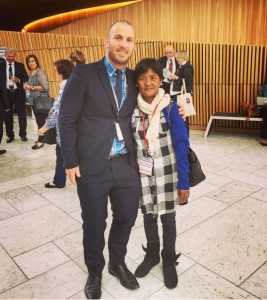
Paul Wilkins and Celia Veloso at the Sixth World Congress Against the Death Penalty in Oslo, Norway.
Source: Paul Wilkins Instagram
On the last day of the World Congress, after the closing ceremony, participants marched downtown from Oslo’s City Hall. Drummers led the march and chants rang throughout the city’s busy shopping district. Holding a sign in English and French — “SAY NO TO THE DEATH PENALTY” — Wilkins wore the suit he wore to Chan’s funeral, which now hung loose on his frame. He walked alongside Ndume Olatushani — a man from Tennessee who spent decades facing execution for a crime he did not commit — and Susan Kigula, a Ugandan woman, also innocent, who was released from death row just this year. At the end of the march, in a square across from the Opera House, participants gathered around a plain white banner. They put on blue plastic gloves and dipped their hands in bright paint, pressing their hands on its surface. Red and blue handprints collected until the banner was covered. Later, Wilkins posted a photo on Instagram from earlier that day. Wilkins is smiling, with his arm around Celia Veloso. Underneath it, he explained who she was, her connection to Andrew, and the uncertain fate of her daughter. “She’s still in prison on death row,” he wrote. “Celia and I are both committed to seeing the death penalty ended worldwide.”
_______________________________________
Liliana Segura – ✉liliana.segura@theintercept.com
Go to Original – theintercept.com
DISCLAIMER: The statements, views and opinions expressed in pieces republished here are solely those of the authors and do not necessarily represent those of TMS. In accordance with title 17 U.S.C. section 107, this material is distributed without profit to those who have expressed a prior interest in receiving the included information for research and educational purposes. TMS has no affiliation whatsoever with the originator of this article nor is TMS endorsed or sponsored by the originator. “GO TO ORIGINAL” links are provided as a convenience to our readers and allow for verification of authenticity. However, as originating pages are often updated by their originating host sites, the versions posted may not match the versions our readers view when clicking the “GO TO ORIGINAL” links. This site contains copyrighted material the use of which has not always been specifically authorized by the copyright owner. We are making such material available in our efforts to advance understanding of environmental, political, human rights, economic, democracy, scientific, and social justice issues, etc. We believe this constitutes a ‘fair use’ of any such copyrighted material as provided for in section 107 of the US Copyright Law. In accordance with Title 17 U.S.C. Section 107, the material on this site is distributed without profit to those who have expressed a prior interest in receiving the included information for research and educational purposes. For more information go to: http://www.law.cornell.edu/uscode/17/107.shtml. If you wish to use copyrighted material from this site for purposes of your own that go beyond ‘fair use’, you must obtain permission from the copyright owner.